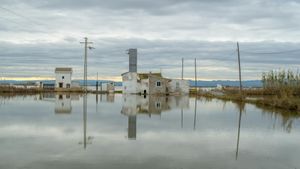Pakistan is currently grappling with one of its worst environmental crises as toxic smog blankets the Punjab province, affecting daily life and posing serious health threats to millions of residents. Satellite images reveal massive clouds of gray smog not only shrouding cities like Lahore and Multan but also extending eastward deep across the border to India, particularly over New Delhi, marking what authorities deem unprecedented pollution levels.
Reports indicate record-breaking levels of air pollution have persisted since last month. According to insights from NASA's Worldview, this thick smog can be clearly viewed from space. Sometimes, the air quality index (AQI) for cities has even crossed alarming thresholds. For example, Lahore recently saw its AQI spike above 1,200, and Multan surpassed the staggering level of 2,000.
This sudden influx of pollution can largely be attributed to seasonal changes combined with human activities. Each winter, agricultural practices like the burning of crop residue, emissions from coal-fired power plants, and increasing vehicular traffic contribute to the formation of dense smog. Cold weather conditions tend to trap pollutants close to the ground, exacerbated by windless days, worsening air quality considerably.
The local health effects have been dire. Hospital reports from across Punjab reflect severe increases in cases of respiratory illnesses, with more than 30,000 individuals treated for ailments directly associated with the poor air quality. These conditions often manifest as throat irritation, coughing, and eye infections, demanding urgent attention from health officials and authorities.
Authorities have responded by implementing proactive measures, including closing schools, parks, and public spaces until November 17 to protect the public from hazardous air. Restrictions on outdoor activities were also introduced, with the provincial government advising against unnecessary travel to reduce exposure. Parks, museums, zoos, and outdoor sports events were suspended under the new regulations to minimize health risks, primarily for vulnerable populations such as children.
The United Nations Children's Fund (UNICEF) has sounded alarms, expressing significant concern over the impact of air pollution on young children. UNICEF's representative, Abdullah Fadil, stated, “Young children are most affected by air pollution because they have smaller lungs and lack the immunities developed through age.” Estimates suggest over 11 million children under the age of 5 are currently at risk due to the alarming levels of smog.
Khuram Gondal, the country director of Save the Children, highlighted the long-term consequences of such environmental hazards on children, stressing the need for the government to address pollution sustainably. He said, "Air pollution and hotter temperatures are leading to life-threatening dangers for children, including difficulty breathing and higher risk of infectious diseases."
Health officials are warning of the detrimental effects of PM2.5, the most dangerous form of particulate matter, which can penetrate deep lung tissues and enter the bloodstream, significantly raising the risk of heart disease, asthma, cancer, and other chronic conditions. On Monday, Multan reported PM2.5 concentrations 110 times higher than the levels considered safe by World Health Organization standards, raising eyebrows globally about the situation.
Addressing the transboundary nature of air pollution, Punjab's Secretary for Environment and Climate Change, Raja Jahangir Anwar, has taken initial steps toward engaging with the Indian government to discuss cooperative approaches to air pollution reduction. Such climate diplomacy is increasingly acknowledged as necessary, not just regionally but globally, to tackle issues exacerbated by climate change.
Experts project worsening conditions as the climate crisis accelerates, with extreme weather events becoming more frequent, potentially impacting pollution levels and dispersal. A recent report indicated high consumption rates of oil, coal, and gas, highlighting the urgent need for systemic changes to energy policies and environmental protections.
While daily life muddles through the dense haze, the pressing concern remains clear: swift action is needed to mitigate this crisis. Authorities are under increasing pressure to implement effective long-term solutions to prevent future smog episodes and safeguard the health of millions.



